January 17, 2005
Big
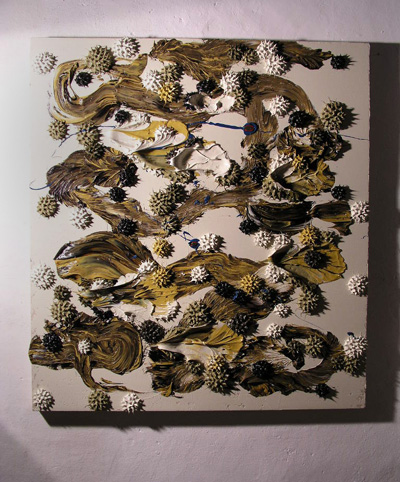
Small painting, big monads.
How big is big?
Why big?
My old friend Gary asked me in a previous comment:
sometimes when I see the "blow-up" version of the paintings, I wonder if you ever try to paint the blow-up version to start with.
Scale.
I've been thinking about scale for a while now. It goes back to my early architecture days when I realized how cities have been governed by a transformed inhabitant, the prothesis augmented citizen (people in cars), and that the intimate human scale of older cities was nearly accidental. And more significantly, I realized that we face the question as to whether we can direct the course of our future or whether our inventions direct us instead (I write this not as a Luddite but as a wary enthusiast). Had I stayed the course in architecture ...which was not my sole intention by the way... (I still keep my licence, so that is and will always be an open option) the next step would have been to determine the consequences of this point of view in the approach to the design of individual buildings. (I imagine an arc connecting Rem Koolhaas with Ted Smith with Leon Krier.)
Later, I chose the closed set of painting over the open set of new genre art (anything goes, the world is on your pallette) because I could detect the twist of irony in the diminished harvest of the open set and I could not have abandoned the hope formed in my childhood for a new horizon in the closed set of sticky colors on a surface stretched flat. It was the early 90's and painting (in the affirmative, not in negation as most painters had done previously -my assessment) simply was a major challenge, the question of scale in painting was not yet on my radar.
At the mid 90's, I had realized that this wet into wet -paint as color, line and mass was a deep well and worthy of my complete attention. Most of my paintings then were of the size of an embrace. As time went on, mild calls for larger works were coming from various important people in my life. And as time went on, I realized to the contrary that there are qualities in these paintings that are intimate... they came from the radius of movement of fingers and wrist. Moreover, I was learning about the nature of paint, a small attraction force of volume-to-surface that you can feel in the stickiness of pallette knife to canvas, the physics of whips and peaks and strings formed from controlled flings, the finitude of a loaded brush carving into waves of pigment.
This learning curve also alerted me to how the properties of paint as material act in scale, that I wouldn't get the same forms if I scaled up the size of my tools tambien. For example, I use shards of paper to peel up fractal patterns of paint (recalling Earnst's decalcomania) and printing this onto the surface, I then flatten the peaks down, reinforcing the graphic quality. The heaviness of the paper stock and the length are important issues in delivering the desired forms.
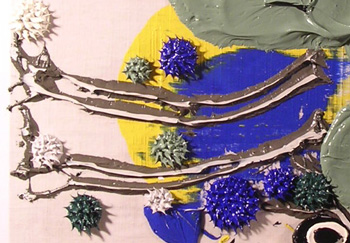
I could use larger, industrial sizes... I could use light gauge sheet metal instead of paper. I would need assitants and larger surfaces to prepare the bed of paint and I began to imagine hydraulic robotic arms in the studio. Robocop as painter. But paint would act differently in these conditions and it's anybody's guess as to what these forms would be like (eh... If I had teh capacity to do this, I would likely find virtures in the new jumbo dabs no doubt). One could not test this without bank and bone crushing effort... it would also outstrip the scale of my little economy. The deliberate facts of intimacy began to become clearer to me then.
There was an issue with paint as mass and how it behaves as it dries. I knew that there is an upper limit somewhere. The paint I use compacts a bit as it dries, I tested bits here and there and found that over time, the paint dries from the surface to the interior, eventually drying like a cookie. Colors affect the drying process, and the darker ones tended to wrinkle when in a mass. Some of these changes I am willing to tolerate, some not. Painting after all is the most fugitive of the artforms, none really survived deep antiquity (hell, I have to survive the shallow contemporary!). Painting alla prima is a way to shortcut the elaborate approaches of traditional technique, but it has it's own problems. Strategies such as painting on canvas stretched over rigid panels adn keeping the mass down are good precautions enough. Painting with larger, deeper masses would bring a host of new conservation problems... and would introduce the open set into my project. If I would move into that direction, I might as well rip open the set and leave painting altogether.
One of the first deliberate investigations in the direction of scale was a group of paintings sent to a show in my gallery in New York, Nicole Klagsbrun. I began by cropping the work in one of my catalogs. I cut one up, and soon I had shards of images on my table. I saw in the cropping, a focus and intesification and I wondered if there was a way to paint this directly. Soon after, my attention drifted to collage and I was making what are essentially maquettes. Instead of cropping down, I was cropping up... assembling repeatable shards until I got the density I wanted.
(...for some reason, I can't load images of these paintings... ?que lastima!)
Just before we left Los Angeles, I had painted long horizontal paintings. It was a way to paint large (4 meters horizontally) and yet small (80 centimeters vertically). I chose to rush across the surface with trowelled pigments and punctuate this movement with the then newly invented pillow-tools and vertical cuts that slowed the horizontal movement down and provided a way to mask the joints (it came apart into three segments). I knew that the slather had AbEx roots and I had hoped that the punctuations would be cause enough for a pause in that judgement. (However, one judgement from Europe was an uncomfortable association with Art Informel... the European aspect of what was known in NYC as AbEx... our artworld is still in the trall of the open set and thus fears what the open set rejected.... this needs a separate post.)
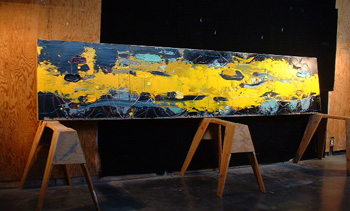
I came away from these paintings with a heightened regard for the problems of translating the intimacy of my little paintings into larger scaled works. Maybe it is because I am born half and half... I tend to think in two directions simultaneously... but my mind went towards problem solving the large while realizing the importance of the small domain.
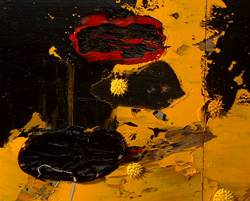
The paintings in Texas began breaking away from the drywall knife, the tool that began nearly all the preceeding work. This tool delivered a uniform bed of paint, a starting point, the wet surface upon which the loaded brush would spend itself (this was the manner in which the initial epiphany occurred to me). But this tool also had it's limits. There was a limit to how big a surface I could create uniformly with a 12 inch blade. So I looked for other ways to start, alternatives to the priming field.
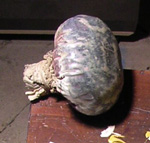
In Spain, I used the pillows to push areas of paint onto the surface as a starting manuever. It was a liberating feeling. I could go omnidirectionally. I could use different colors and tones. More importantly, I realized that I could use a fresco technique and work on parts of the canvas at a time, unlike the trowel which committed me to the entire surface at the onset. I could in theory start a large canvas and complete it piecemeal (as it is, a painting consumes me for a week at a time, and since the paint is drying, I am agitated until I am done before it dries).
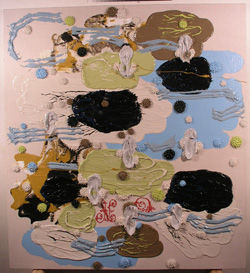
I painted all summer before I fully exploited this potential, exploring the ramifications of this new approach. Along the way, I discovered that in addition to pushing on pillows of paint, I could take it off, flattening the surface, thus keeping the overall mass down.
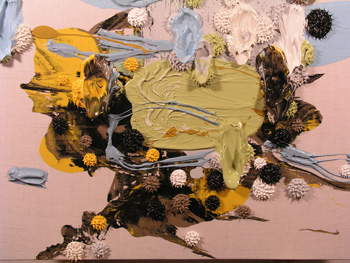
The show in Z?rich represents for me a capsule example of a fruitful The last three paintings worked out a combination of lessons learned that summer (I number them sequentially), a sort of codification. Thick and flat, marbled and solid, strings and fractal prints and lines and planes and spiney balls.

I was good to go for larger work. An interlude of works on paper and some panels for a group show gave me a pause and a moment to examine the other hand. And then, I took on the two larger paintings that will go into the K?ln show in March. The thing is, this peicemeal "fresco" strategy is good in theory, but it's a beast in practice. One large painting, sectioned into five or six parts, will take me a month to do! If I wanted to paint bigger,faster... industrial dimensions are required. I'm happy I've taken on the last two paintings of course. But in the next larger panel (Ramon promises a delivery tomorrow) I think I'll be using the scalability (the ability to go large) of the flat areas to wrestle with the span of the canvas.
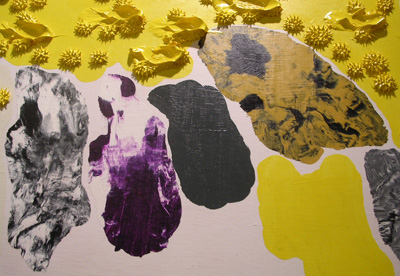
...well, that takes us up to this moment. And there's another panel which the same size as the last painting. I was planning a similar approach as before (chocolate paintings).. but now I've been thinking about this detail:
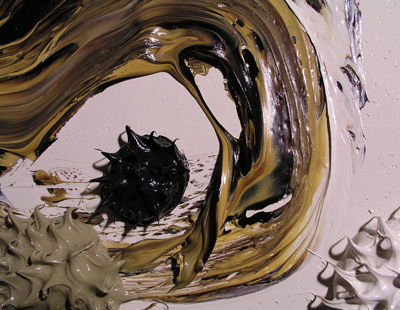
...in technicolor.
And to answer Gary question more directly: Why don't I paint the blow up?
-Well, I already did. And I have a foto to prove it.
Posted by Dennis at January 17, 2005 6:26 PM
Leave a comment